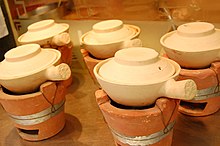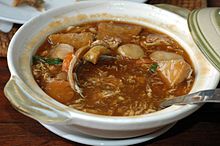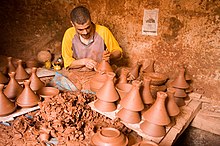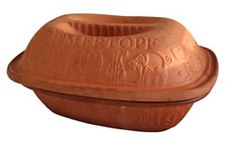Where To Buy Clay Pots For Cooking In Nj

Cooking of svadbarski kupus (wedding ceremony cabbage) in ceramic pots, Serbia
Clay pot cooking is a procedure of cooking food in a pot made of unglazed or glazed pottery.
History [edit]
Cooking in unglazed clay pots which are first immersed in water dates at least to the Etruscans in kickoff century BC but likely dates to several centuries earlier.[i] The Romans adjusted the technique and the cooking vessel, which became known as the Roman pot, a cooking vessel similar to those made since the 1960s by Romertopf.[1] [ii]
In the Han Dynasty, pots unglazed on the exterior known every bit fus (now called sandy pots) were used for wet clay cooking.[one]
In Nippon dirt pots are mentioned from the eighth century and originally referred to as nabe. As pots made from other materials entered use, the Japanese clay pots were distinguishe by calling them donabe; "practise" means clay or earth.[three] : 3
Cooking in dirt pots became less popular once metal pots became available.[4] Clay remained popular for those dishes that depended on the unique qualities of clay cooking; Food & Wine called out such dishes equally biryani, cassoulet, daube, tagine, jollof rice, kedjenou, cazuela, and broiled beans.[4]
Backdrop [edit]
Clay cookers let food to be cooked with minimal additional liquids or fats.[5]
Individual clay bed are considered to provide specific properties for cooking, and cooking vessels of a particular blazon oft are valued for being made of the traditional blazon of dirt.[4] The micaceous clay establish at Taos Pueblo holds heat for a long time.[four] The pots made from this clay are considered to contribute flavour to what is cooked within them.[four]
The clay from Lake Biwa contains tiny fossils which incinerate and produce minor pockets of air, which also hold heat.[iv] The pots made from this clay are considered to contribute to flavor to what is cooked within them.[3] : 6
Nutrient & Wine tested multiple dishes in multiple clay pots and said that "In test later test, we found that everything cooked in clay tasted better than the same recipes cooked in metallic pans" and that the only drawback to using clay cooking vessels is that they weren't indestructible.[4]
Cooking techniques [edit]
Dissimilar cultures accept different techniques of cooking nutrient in dirt pots. Some utilize pots that are fully finished past burnishing and therefore do not require the pot to be soaked each time earlier utilise. Some are unfinished and must exist soaked in water for 30–45 minutes earlier each apply to avoid cracking. The pattern and shape of the pot differ slightly from 1 culture to another to suit their style of cooking.
Seasoning is of import to prevent neat of the vessel when exposed to high heat. Clay pots are initially seasoned with oil and hot water but may be fully seasoned but after the first several uses, during which food may take longer to melt. It is also essential to avert sudden temperature changes, which may cause the pot to crack. Heat should exist started low and increased gradually both on the stovetop and in the oven.
The food inside the pot loses little to no moisture considering it is surrounded by steam, creating a tender, flavorful dish. Water captivated within the walls of the pot prevents burning and so long as the pot is not immune to dry completely. Because no oil needs to be added with this cooking technique, food cooked in dirt is often lower in fat than food prepared past other methods.
Wet clay cooking [edit]
The Chinese sandy pot and the Romertopf are both soaked earlier beingness filled with food and covered with the lid, which has besides been soaked.[one] Both pots go into a cold oven.[1] The sandy pot tin can also be started on the stove on a burner ready very low.[1]
Characteristics [edit]
Food cooked in dirt is widely considered to acquire an "earthy" gustation from the pot. Pots used for many years are believed to acquire a seasoning that contributes to the dish, and cooks oftentimes hope to larn the pots used past their predecessors.[6]
In Asian cuisines [edit]
Balkans [edit]
In the Balkans multiple cuisines use a dirt pot, ofttimes chosen a guvec, to cook ghivetch and other related dishes.[7] : 88, 133 The comleks is a Turkish bean pot.[8] : 241
South Asia [edit]
In the southern states of Andhra Pradesh, Kerala, Tamil Nadu and Telangana in India, the traditional pot used for cooking is called a chatti. There are many unlike types of pots used in the different cultures of North India, Pakistan, People's republic of bangladesh.[ commendation needed ]
India [edit]
In northern states including Punjab, Uttar Pradesh, Haryana, Rajasthan, the cooking pots are called handi. Traditionally, Indian chefs could melt many dishes simultaneously by stacking handi while cooking. In southern states of Andhra Pradesh, Kerala, Tamil Nadu and Telangana, the cooking pots are called 'man panai','man satti' in Tamil, 'kunda', 'matti kunda', 'kadava' in Telugu. The traditional pot used Tamil Nadu 'pongal festival' In eastern states, Champaran mutton is a delicacy.[ citation needed ]
Sri Lanka [edit]
People in Sri Lanka use dirt pots to brand many dishes including pahi ("piffling jackfruit") fish curry, called abul thiyal; accharu, a chutney; as well as some meats, rice, and several types of freshwater fish called Lula, Hunga, Magura and Kawaiya.[ commendation needed ]
Greater Red china [edit]

Chinese claypots, used in cooking either food or medicine
In China, the pot used for such cooking is generally known as shaguo (Chinese: 砂鍋; pinyin: shāguō ; Cantonese Yale: sāwō ) or boujai (Chinese: 煲仔; Cantonese Yale: bōu jái ), a Cantonese discussion for "trivial pot". Dirt pot dishes are sometimes labeled every bit "hot pot" or "hotpot" dishes on the menus of Chinese restaurants in English-speaking areas of the earth, but they should non exist confused with hot pot dishes that are served in a large metal basin and cooked at the table. In Taiwan, the chicken dish sanbeiji is prepared in a dirt pot.[ commendation needed ]
Another common Chinese dirt pot is the sandpot or sandy pot, a round pot with a hat, glazed on the within and unglazed on the exterior, which allows them to be soaked before cooking just not add liquid to the ingredients.[9] Afterward soaking the pots are filled with food and placed in a common cold oven or started over a very low burner.[1] As of 1996 sandy pots were made in various sizes from private serving sizes to 5 quart sizes.[1] They are fabricated from a specific clay which is mixed with sand before a very high-temperature firing.[one] The sandy pot evolved from the fu, which was used in the Han Dynasty to cook a dish called weng.[1]
Common dishes are claypot rice and piddling pot rice.
Japan [edit]
In Japan, the donabe is a traditional cooking vessel.[4] [3] It is made from a clay that is porous and coarse.[4] [3] : vii In the surface area around Iga, Iga-yaki (Iga-fashion) donabe, take been made since 1832;[3] : thirteen Iga-yaki pottery in general dates back to the seventh century and is highly valued.[3] : 17–18 Information technology became particularly popular for donabe during the Edo Menses.[3] : xviii The highest-quality donabe tin accept two weeks to make.[3] : 7–8 In that location are multiple styles of donabe made for the grooming of different dishes.[3] : 8
Donabe can be used over an open flame, and food is often served out of the donabe.[3]
A civilization surrounding donabe developed called "nabe o kakomu", which means "surrounding the pot" or a communal meal.[3] : 4 The concept has been featured repeatedly in the media and in donabe cookbooks.[3] : 6 According to Naoko Takei Moore, donabe civilization "teaches the concept of ichigo-ichie, or "every moment is a one time-in-a-lifetime treasure".[3] : 37
With utilize, donabe develop a patina of crackling of the interior coat called kannyu. This patina is valued as a sign of character.[iii] : ix
Korea [edit]
In Korea, the earthenware pot is called ddukbaegi, ofttimes used for soups as seen in Korean restaurants. The stone pot is chosen dolsot, which is heavier and has a more marbled appearance, used to melt dolsot bibimbap.[ citation needed ]
Vietnam [edit]
The stew-like dish kho is cooked in a pot. The pot is well-nigh oftentimes called nồi đất in Vietnamese, although, depending on its size and use, it may as well be called nồi kho cá, nồi kho thịt, nồi kho tiêu, or nồi kho tộ.
Philippines [edit]
The traditional pot used for cooking is the palayok.[ citation needed ]
Republic of indonesia [edit]

Sapo tahu tofu and vegetables cooked in claypot
The traditional pot used for cooking is called kuali or gentong. The famous cuisine is empal gentong (beefiness with coconut milk soup). Chinese Indonesian sapo tahu is tofu and vegetables cooked in claypot.[ commendation needed ]
In African cuisines [edit]
According to Paula Wolfert, "all Mediterranean nutrient used to be cooked in clay."[10]
Ethiopia [edit]
Traditionally, all nutrient was cooked in specialized dirt pots. Some traditional dishes are still cooked in clay pots every bit the same flavor cannot be achieved with metal cookware.[ citation needed ]

Morocco [edit]
The tajine is a N African, two-piece pot used in Moroccan cuisine. The lesser part is a broad, shallow basin, while the peak is tall and conical, or sometimes domed.[11] The tall chapeau acts to condense rising steam and allow the moisture to curl back down into the dish.[6] The tajine lends its name to the meat stew that is typically cooked in this pot.
Another Moroccan dirt pot is the tagra, which is used to broil fish.[ten] A Moroccan bean pot is the gedra.[8] : 241
In European cuisines [edit]
France [edit]
According to Paula Wolfert, "all Mediterranean food used to be cooked in clay."[8] : x In French cuisine the daubiere is used to cook daubes.[8] : 10 A tripiere is a specialized earthenware pot for cooking tripe.[8] : 10 The diable is an unglazed potbellied container used to dry out-cook chestnuts or potatoes.[8] : 222 The tian is a low rectangular pan for making tians or gratins.[11]
Federal republic of germany [edit]

Clay roasting pots called Römertopf ("Roman pot") are a recreation of the wet-clay cooking vessels used past the Etruscans, and appropriated by the Romans, by at least the first century BC.[1] [ii] They are used for a diversity of dishes in the oven and are always immersed in water and soaked for at least xv minutes before existence placed in a cold oven.[1] [2] Since its introduction in 1967, it has influenced cooking traditions in Germany and neighbouring countries.[ citation needed ]
Greece [edit]
A yiouvetsi is similar to a guvec.[ commendation needed ] Moussaka is made in these.[eight] : 229
Spain [edit]
According to Paula Wolfert, "all Mediterranean nutrient used to exist cooked in clay."[ten]
In Spanish cooking a ceramic roaster known as olla de barro is used.[eight] : xiv Another dirt pot used in Spain is the cazuela.[10]
Italy [edit]
According to Paula Wolfert, "all Mediterranean food used to exist cooked in clay."[10]
The pignatta is a vase-shaped pot used for cooking beans in the coals of a fireplace or in a wood-fired oven.[12] [thirteen] [10] Another Italian clay pot is the tiella, which is a broad glazed dirt pot used in Puglia and Calabria.[8] : x, 172 In Tuscany the coccio and fiasco are bean pots.[8] : 245
Dishes commonly prepared in clay pots include ribollita.[viii] : 36–37
In South American cuisines [edit]
Clay pots are used in various South American dishes, including cazuela, which is named for the Castilian cooking pot.[10]
In North American cuisines [edit]
Native American civilizations traditionally cooked in dirt pots, although they fell out of favor subsequently European settlers' introduction of metallic cookware.[ citation needed ] In the modern United States some cooks cull to use clay pots for health or ecology reasons.[ citation needed ]
In New England and other regions, baked beans were traditionally cooked with salt pork in a beanpot in a brick oven for six to viii hours.[14] In the absence of a brick oven, the beans were cooked in a beanpot nestled in a bed of embers placed near the outer edges of a hearth, virtually a foot away from the fire. "Edible bean hole" cooking may accept originated with the native Penobscot people and later expert in logging camps. A fire would be made in a stone-lined pit and allowed to burn down down to hot dress-down, and then a pot with seasoned beans would be placed in the ashes, covered over with clay, and left to melt overnight or longer. The beans were a staple of New England logging camps, served at every meal.[15] [sixteen] [17]
References [edit]
- ^ a b c d east f g h i j chiliad fifty Karoff, Barbara (1996-01-x). "Cooking in Clay". San Francisco Examiner . Retrieved 2022-01-26 .
- ^ a b c Sales, Georgia MacLeod (1974). The clay-pot cookbook : a new way of cooking in an ancient pot. Grover Sales (1st ed.). New York: Atheneum. pp. xi–xii. ISBN0-689-10643-2. OCLC 1113977.
{{cite book}}: CS1 maint: engagement and year (link) - ^ a b c d e f yard h i j k l yard n Moore, Naoko Takei (2015). Donabe : classic and modernistic Japanese clay pot cooking. Kyle Connaughton (First ed.). Berkeley. ISBN978-1-60774-699-7. OCLC 903284492.
- ^ a b c d e f thousand h i Heck, Mary-Frances. "The Food & Wine Guide to Dirt Pot Cooking". Food & Wine . Retrieved 2022-01-26 .
- ^ White, Joanna (1995). Cooking in clay. San Leandro, Calif.: Bristol Pub. Enterprises. ISBNane-55867-118-8. OCLC 32511101.
- ^ a b Wolfert, Paula (2009). Mediterranean clay pot cooking : traditional and modern recipes to savor and share. Hoboken, Northward.J.: John Wiley & Sons. pp. x, sixteen–xvii. ISBN978-0-7645-7633-one. OCLC 298538015.
- ^ Wolfert, Paula (2009). Mediterranean clay pot cooking : traditional and modernistic recipes to savor and share. Hoboken, North.J.: John Wiley & Sons. pp. 88, 133. ISBN978-0-7645-7633-1. OCLC 298538015.
- ^ a b c d e f g h i j m Wolfert, Paula (2009). Mediterranean clay pot cooking : traditional and modern recipes to savor and share. Hoboken, N.J.: John Wiley & Sons. ISBN978-0-7645-7633-i. OCLC 298538015.
- ^ Wolfert, Paula (2009). Mediterranean dirt pot cooking : traditional and modern recipes to savor and share. Hoboken, Northward.J.: John Wiley & Sons. pp. xiv–xv. ISBN978-0-7645-7633-1. OCLC 298538015.
- ^ a b c d e f grand Wolfert, Paula (2009). Mediterranean clay pot cooking : traditional and modern recipes to relish and share. Hoboken, Due north.J.: John Wiley & Sons. pp. 10. ISBN978-0-7645-7633-one. OCLC 298538015.
- ^ a b Jacobi, Dana (1995). The best of clay pot cooking. Elizabeth Watt. San Francisco, CA: Collins Publishers San Francisco. ISBN0-00-225051-9. OCLC 32396677.
- ^ Barbara Goldfield (18 October 2022). "Pizza, Pane & Pignata". ItalianNotebook . Retrieved 12 August 2022.
- ^ Alessia (17 November 2022). "La "Pignata"". Il Sud che non ti aspetti (in Italian). Retrieved 12 August 2022.
- ^ Farmer, Fannie (1896). Boston Cooking-Schoolhouse Melt Book'. p. 212. ISBN0-451-12892-3.
- ^ "Common Footing's Bean Hole Beans". Mofga.org. Archived from the original on 7 March 2022. Retrieved two November 2022.
- ^ "Foodways Research: A Taste of Maine". Maine Folklife Center. Archived from the original on 18 Baronial 2009.
- ^ "Archived copy". Archived from the original on 18 August 2009. Retrieved 2009-08-19 .
{{cite web}}: CS1 maint: archived re-create as title (link), Maine Folklife Center
Source: https://en.wikipedia.org/wiki/Clay_pot_cooking
Posted by: colewavicujjoys.blogspot.com


0 Response to "Where To Buy Clay Pots For Cooking In Nj"
Post a Comment